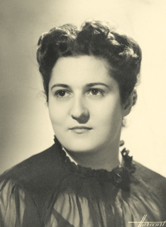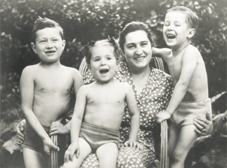|
|
Throughout
her childhood,
Françoise felt misunderstood
by her mother, who saw marriage as her only future—higher education
and a profession seemed counterproductive to that goal. Unable to
remain inactive, Françoise not only decided to learn to sew,
but she also successfully entered poster-making contests. She was
forbidden to take these activities any further, however. She then
began dabbling in ceramics, but the repetitive nature of the task
discouraged her. All her life, however, Françoise retained
an artistic inclination and produced sculptures, drawings, and watercolors.
In 1929,
her mother finally allowed Françoise to study nursing,
in the hope it would dissuade her from wanting to become a doctor.
Françoise nevertheless stuck to her plan.
She
waited until her younger brother, Philippe, was ready, and then
they entered medical school together, ultimately enabling Françoise
to begin practicing as a family doctor and pediatrician on September
1, 1939.
 |
Having
broken off an engagement – arranged by her parents
– when she began her medical studies, Françoise started
displaying neurotic symptoms linked to a dreadful feeling of guilt,
which led her to seek psychoanalytical help. Little by little, her
successful psychoanalysis
(from 1934 to 1937) by René Laforgue, her admission
to the Psychoanalytical Society of Paris, and her hospital work
(where she encountered disturbed children),
enabled Françoise Marette to fulfill her early wish
to become a “doctor of child-rearing” and to evolve into
the psychoanalyst so renowned today..
Her psychoanalytical mentors
were Lowenstein,
Spitz, and Garma and – when it came to child analysis –
Morgenstern and Leuba. Later, Françoise Dolto
became one of the founding members of the French Psychoanalytical
Society (from which she would subsequently resign, along with Jacques
Lacan, during
a schism). In 1964, Dolto was one of the founding members, with
Lacan once more, of the Freudian
School of Paris..
In 1942, Françoise married
Boris Ivanovitch Dolto,
a doctor who specialized in rhumatology and who founded the French
School of Orthopedics and Massage. Boris
was as revolutionary and innovating as Françoise,
and is said to have made a major contribution to the field of physiotherapy.
Opened-minded and modern, Boris enthusiastically shared his wife’s
intellectual career,
just as Françoise enthused over her husband’s discoveries.
Their joint analyses of the links between body and psychology were
extremely enriching for
both of them. The couple had three children.
 |
Alongside
her private practice at home, where she received many
adults, Françoise Dolto worked primarily
in four medical institutions where she treated children: the Ney
Polyclinic (where she had been recruited by Jenny Aubry), the Claude
Bernard Center, the Trousseau Hospital (1940 to 1978), and the Etienne
Marcel Center (1962 to 1985).
|
|
Starting
in 1967, Dolto answered live questions from listeners,
both adults and children, on Europe One radio station. She did so
anonymously, known only as “Dr. X.” The radio show attracted
many listeners, yet Dolto put
an end to the experiment in 1969, mainly because dialogue was seriously
disrupted by the constraints
of a live broadcast and by commercials. In 1976, she agreed to do
a program on France Inter radio station, called “When the Baby
Shows Up,” on the condition that she would reply to listeners’
letters, which allowed her
to respond much more fully. The program was a great hit and was
the origin of her fame among the general public
in France..
In 1978, this media success
induced Dolto to retire from her psychoanalytic practice—transference
effects related to her fame seemed to alter the nature of her work
in
a way that seemed incompatible with her professional ethics. The
issue of ethics in therapeutic practice was also crucial to Dolto.
She henceforth devoted herself primarily to prevention and training
rather than cure,
by conducting individual and group supervision, and by publishing,
lecturing, and making radio and television broadcasts.
In 1979, accompanied by a small team,
Dolto founded the Maison Verte, a “nurture center” for
the social education of infants from birth to three or four years
old. It is a place where the child, accompanied by one or both parents
or grandparent(s), will find a professional team of three, one of
whom is a psychoanalyst. A Maison Verte is a place for talking,
playing, and reducing tension, even as constructive prohibitions
are inculcated. The success of this approach has led to the spread
of Maisons Vertes, and a great many now exist in most countries
in Europe (especially France, see: Maison Verte) and in Latin America.
During this period, however,
Dolto was particularly keen to continue her psychoanalytical practice
first at the Etienne Marcel Center and later among children placed
with the social services (work that she performed up to her death).
She felt that the very young age and situation of such children
shielded them from her notoriety. As at the Trousseau Hospital,
Dolto’s sessions were conducted
in the presence of other psychoanalysts who formed an active group
to whom the child could turn. Dolto greatly valued this method of
training, simultaneously theoretical and clinical, even though she
always stressed the fact that she didn’t want to establish
a “school” and that she had no students in the strict
sense of the term. Psychoanalytical work with tiny children, including
new-borns, was extremely important to Dolto because
she saw it as a means of preventing later problems.
Prior to her death, she strongly militated for the continuation
of this type of work.
As
a Freudian,
Dolto developed innovative theories and clinical practices
that have deepened and extended our knowledge of human nature, notably
by stressing the importance of remaining alert to unique features
of child development that she labeled “archaic.” Along
the way, Dolto elaborated a concept crucial to her thinking, namely
“the unconscious ../image of the body.” Within this theoretical
framework, she also developed the notion
of “symbol-generating castrations” as a necessary stage
in the growth of the child.
Nowadays, many institutions
inspired by Dolto’s philosophy are springing up in France and
the rest of
the world: nurture centers of the Maison Verte type, neighborhood
day-care facilities that take children after school, special hotels
for children, places where children can meet with divorced parents
experiencing social problems or conflicts, mother-and-child rooms
in hospitals, and therapeutic centers for mother and newborn where
fathers are obviously welcome (Dolto also stressed the fact a child’s
development occurs within a very early triangulation between its
mother and its father).
All these institutions reflect
Dolto’s constant concern
to undertake preventive care, based on everything she learned about
suffering from the children and adults in therapy. One little-known
effort, for instance, was Dolto’s campaign to teach sign language
to hearing-impaired children at a very early age. Hundreds of places
have
now been named after Françoise Dolto—streets, squares,
parks, toy libraries, day-care centers, kindergartens, schools,
and so on.
Françoise
Dolto was both psychoanalyst and concerned citizen – her
work has undeniably contributed, along with the work of many others,
to the profound changes in the way children are now perceived by
psychoanalysts and
by society as a whole.
|